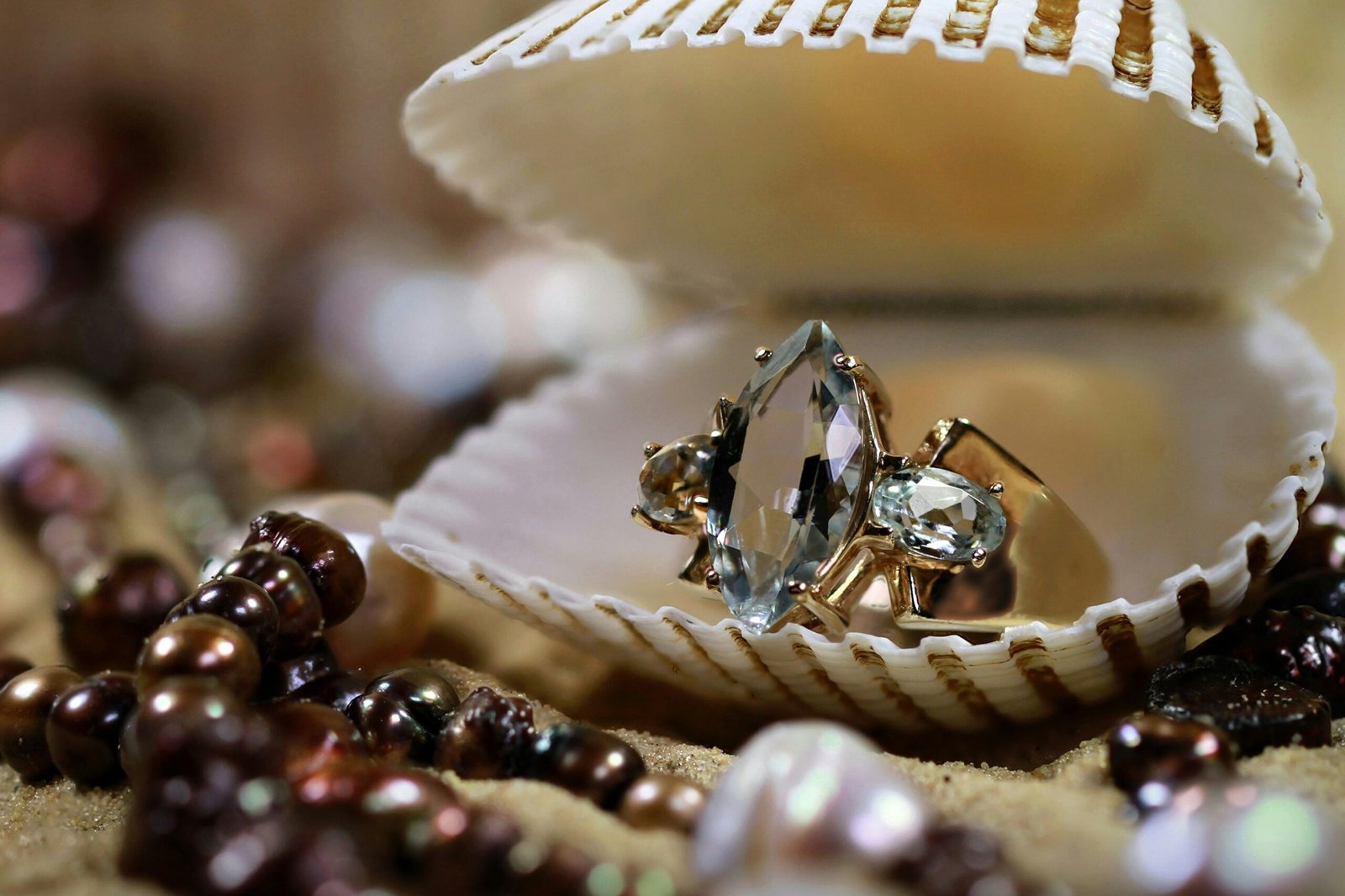Introduction to Gemstones in Jewelry
Gemstones have captivated humanity for centuries, serving as symbols of wealth, beauty, and status across various cultures. Each gemstone possesses unique attributes, including color, clarity, cut, and carat weight, which contribute to its overall aesthetic appeal and market value. The broad spectrum of gemstones ranges from precious stones like diamonds, sapphires, and emeralds to semi-precious varieties such as amethyst, garnet, and turquoise. The enduring fascination with these natural treasures has deep roots in human history and continues to influence contemporary jewelry design.
The emergence of gemstones in jewelry making can be traced back to ancient civilizations, where they were not only employed as adornments but also held significant cultural and spiritual meanings. Many societies believed that specific stones possessed healing properties or offered protection against harm. For example, lapis lazuli was revered in ancient Egypt, where it symbolized royalty and divine favor. In the realm of fashion, gemstones have evolved from simple adornments to crucial elements in elaborate jewelry design. Their brilliance and rarity add unparalleled elegance to a piece, making them highly sought after in both traditional and modern contexts.
Throughout history, gemstones have transcended their decorative purposes, becoming integral to societal norms and expectations. They have played an essential role in signifying milestones, celebrations, and social status, cementing their place in the fabric of various cultures. As we explore the significance of gemstones in jewelry design, we uncover their multifaceted nature—their ability to reflect personal style while carrying historical weight. By understanding their timeless allure, we can appreciate the craftsmanship and artistry involved in creating exquisite jewelry that continues to resonate with individuals across generations.
The Historical Significance of Gemstones
Throughout history, gemstones have held considerable significance, not only in the realm of jewelry design but also within various cultures. The ancient Egyptians, known for their advanced civilization, were among the first to utilize gemstones extensively in their jewelry. They believed that stones such as lapis lazuli and turquoise possessed divine properties, promoting protection and good fortune. Many Egyptian tombs revealed exquisite jewelry adorned with carefully cut gemstones, which were meant to accompany the deceased in the afterlife.
Another civilization that highlighted the importance of gemstones was the Romans. They adopted various gemstones from the regions they conquered, such as emeralds from Egypt and diamonds from India, and incorporated them into their jewelry pieces. Romans viewed gemstones as symbols of power and status; therefore, the fashion of the elite often included intricate designs featuring various precious and semi-precious stones. These gems were not simply decorative but also served as talismans believed to bring luck, health, and protection.
The Indian subcontinent also holds a rich history of gemstone use in jewelry design. The Indian royalty, particularly during the Mughal era, showcased elaborate jewelry pieces made with a plethora of precious stones. Rubies, sapphires, and pearls were meticulously crafted into stunning designs that highlighted the skill of artisans at the time. Furthermore, gemstones in India often featured symbolic meanings, such as the belief that specific stones could influence the wearer’s fate or enhance their virtues.
From ancient rituals to adornments of royalty, gemstones have significantly shaped cultural identities and traditions. The craftsmanship involved in their sourcing and design reflects the artistry of the respective civilization. As we explore the fashion dynamics today, the rich historical context of gemstones continues to inspire modern-day jewelry design, maintaining their allure throughout the ages. The innate connection between gemstones and human spirituality remains a testament to their enduring legacy.
Cultural Symbolism of Gemstones
Throughout history, gemstones have held significant cultural meaning in various societies, serving as symbols of power, spirituality, and healing. Many cultures have attributed special properties to these natural treasures, believing that they possess energies that influence life events and personal well-being. For instance, in ancient Egypt, gemstones such as lapis lazuli were revered not only for their beauty but also for their connection to the afterlife. They were commonly used in burial artifacts and jewelry, signifying protection and royal status.
In contrast, cultures in the East, such as those practicing Ayurveda, often utilize gemstones like emeralds and rubies as tools for holistic healing. The belief in the purported healing vibrations emitted by these stones reflects a deeper connection between nature and human health. Such practices are ingrained in traditional medicine, showcasing gemstones as vital instruments in spiritual wellness and self-discovery.
Furthermore, the symbolism of gemstones varies widely among different cultures, encompassing folklore and mythology. In many Native American tribes, turquoise is considered a sacred stone, symbolizing protection and healing. It is often used in tribal jewelry and ceremonial artifacts. In Hinduism, gemstones are associated with specific planetary influences and are integral to astrological practices, reflecting not only personal attributes but also societal values concerning luck and prosperity.
This diversity of beliefs highlights the multifaceted role gemstones play in human expression and cultural identity. As jewelry design continues to evolve, these legacy meanings persist, ensuring that each gemstone is imbued with rich historical context and cultural relevance. Understanding the cultural symbolism of gemstones allows one to appreciate not only their aesthetic value but also the deeper significance they carry across different societies.
Gemstones as Status Symbols
The association between gemstones and wealth has a rich history that is deeply intertwined with cultural significance across various societies. Throughout different eras, gemstones have served as powerful status symbols, particularly in monarchic contexts, where their opulence was a reflection of royal power and prestige. These precious stones, ranging from diamonds and rubies to sapphires and emeralds, have frequently adorned the crowns, scepters, and jewelry of kings and queens, signifying not just personal wealth but also a nation’s grandeur.
For instance, the British Crown Jewels include several famous gemstones, such as the Imperial State Crown, which features the prestigious Cullinan II diamond. Exhibiting both exceptional beauty and significant value, these jewels not only highlight the wearer’s status but also serve as national symbols. In many cases, the history behind these gemstones is as captivating as the stones themselves. The revenues from resource-rich gemstone mines often funded conquests and wars, making gemstones an emblem of power throughout history.
This persistent relevance of gemstones in fashion and jewelry design illustrates their cultural significance, which has been established for millennia. As such, the representation of wealth, status, and power in society is often manifested through the selection and use of specific gemstones, reinforcing their esteemed place in the world of jewelry design.
The Art of Gemstone Cutting and Design
The world of gemstones is not only captivating due to their inherent beauty but also because of the intricate artistry involved in their cutting and design. Gemstone cutting is a highly specialized craft, where skilled artisans employ various techniques to enhance the natural allure of stones and transform them into spectacular elements of jewelry design. The precision and creativity displayed during this process can greatly influence the final aesthetic of the piece.
One of the most common cutting styles is the faceted cut, which involves creating numerous flat surfaces on a gemstone, allowing it to capture and reflect light effectively. This technique is particularly popular for popular gemstones such as diamonds, sapphires, and emeralds, as it maximizes their brilliance and play of color. Another well-known style is the cabochon cut, characterized by its smooth, rounded surface and lack of facets. This method is often used for opaque stones like turquoise and lapis lazuli, highlighting their color and texture rather than sparkle.
Over the years, gemstone design trends have evolved, influenced by cultural shifts and fashion movements. For example, the Art Deco period of the 1920s celebrated geometric shapes and bold colors, leading to innovative cutting techniques that complemented the distinctive jewelry styles of the time. In contrast, the minimalist trends of the late 20th century shifted focus towards understated elegance, encouraging the use of simple settings and natural shapes, often highlighting the inherent qualities of the gemstones themselves.
Today, designers continue to experiment with both traditional and modern gemstone cutting methods, ensuring that the process remains an art form in its own right. The interplay between cutting styles and cultural influences not only enhances the aesthetic appeal of gemstones in jewelry design but also reflects the rich history and ongoing evolution of fashion. As such, each gemstone carries with it a story shaped by the hands that have crafted it and the cultures that have embraced it.
Modern Day Gemstone Trends in Jewelry
In recent years, the trends surrounding gemstones in jewelry design have evolved significantly, reflecting broader cultural shifts and consumer preferences. A key trend is the growing demand for ethically sourced gemstones. Conscious consumerism has prompted jewelers to prioritize transparency in their supply chains, leading to increased offerings of stones that are mined and traded responsibly. This focus on ethical practices not only ensures fair labor conditions but also appeals to a market increasingly concerned with sustainability and environmental impact.
Alongside the rise of ethical sourcing, alternative gemstones have surged in popularity. Consumers are now embracing less traditional options such as lab-created stones, semi-precious gems, and unique colored alternatives. These alternatives often provide a more affordable yet distinctive choice for those who seek individuality in their jewelry. Furthermore, the use of alternative gemstones allows for greater creativity in design, as artists experiment with a wide range of colors, shapes, and textures, breaking away from conventional norms.
The blending of traditional techniques with modern aesthetics has also defined contemporary jewelry trends. Artisans are reviving age-old methods of gemstone setting and crafting, such as filigree and hand engraving, while integrating contemporary styles and materials. This fusion not only preserves cultural heritage but also offers a fresh interpretation of timeless practices. Jewelry designers are increasingly showcasing gemstones in innovative ways, often mixing them with unconventional materials like leather or resin, thereby appealing to a diverse audience that values both history and avant-garde fashion.
Ultimately, these modern trends reflect a profound transformation within the jewelry landscape, where the allure of gemstones continues to inspire while adapting to the evolving tastes and values of contemporary society.
Gemstones in Wedding and Engagement Jewelry
Gemstones hold a particularly significant place in the realm of romantic jewelry, especially in the context of engagement rings and wedding bands. Traditionally, diamonds have reigned supreme as the gemstone of choice for engagement rings, symbolizing purity, commitment, and enduring love. This enduring preference is largely attributed to the marketing campaigns of the mid-20th century, which popularized the notion that “a diamond is forever.” However, the world of wedding and engagement jewelry has evolved significantly over the years, giving rise to a broader palette of gemstones that reflect personal tastes and meanings.
In recent years, sapphires have gained popularity as a fashionable alternative to diamonds. Their rich hues, particularly the classic royal blue, evoke a sense of regality and have even been sported by celebrities and royals alike. Additionally, sapphires are associated with wisdom and nobility, making them a meaningful choice for couples seeking to express their unique love story. Other gemstones, such as emeralds, rubies, and even alternatives like morganite and aquamarine, are also becoming increasingly favored for their distinctive colors and personal significance.
As modern couples seek to differentiate their wedding and engagement jewelry, trends have emerged that prioritizing ethical sourcing and alternative stones. Lab-grown diamonds and sustainably mined gemstones offer environmentally friendly options that appeal to the conscientious consumer. Furthermore, many couples are now opting for vintage or heirloom pieces, incorporating family history into their jewelry design. This shift highlights not only the importance of gemstones in marking significant life events but also showcases a growing appreciation for individuality and personal narrative in romantic jewelry.
Preserving the Legacy of Gemstones in Jewelry
The preservation of historical gemstone jewelry plays a crucial role in understanding the evolution of fashion and cultural significance. Gemstones have captivated people for centuries, not only for their beauty but also for their symbolism and meanings within various societies. As jewelry design continues to evolve, the conservation of these exquisite pieces ensures that future generations can appreciate the artistry and craftsmanship that went into each creation. However, this endeavor is fraught with challenges, as the materials used in ancient jewelry can be quite delicate and susceptible to degradation over time.
Museums and galleries are at the forefront of preserving the legacy of gemstone-encrusted jewelry. These institutions invest significant resources into acquiring, documenting, and maintaining collections that often represent the pinnacle of artistic achievement in jewelry design. By employing trained conservators, museums can ensure that historical pieces, such as crowns and royal regalia adorned with gemstones, are preserved in optimal conditions. This often involves stabilizing the environment in which the jewelry is displayed, controlling temperature, humidity, and light exposure to mitigate risks of damage.
Collectors and historians also play an essential role in this preservation effort. By meticulously cataloging and researching gemstone jewelry, they contribute to a broader understanding of its significance in various cultures and eras. Their work sheds light on how gemstones have influenced fashion and social customs throughout history. Additionally, they advocate for the importance of preserving these artifacts, helping to raise awareness about the threats posed by neglect, illicit trade, and the loss of traditional craftsmanship.
Ultimately, the legacy of gemstones in jewelry design is not only a celebration of beauty and creativity but also a vital link to our shared cultural heritage. Ensuring that these remarkable pieces are preserved allows us to honor the past while inspiring future generations to continue exploring the fascinating world of gemstones in fashion.
Conclusion: The Enduring Legacy of Gemstones
Throughout history, gemstones have played a crucial role in the realm of jewelry design, embodying a rich tapestry of cultural significance and human emotion. From ancient civilizations that revered these stones as symbols of power and protection to modern fashion trends that often feature unique and exquisite gems, the allure of gemstones remains undiminished. Jewelry crafted from these natural wonders often serves more than just the purpose of adornment; it acts as an expression of individual identity and style, encapsulating stories that transcend time and geography.
The variety of gemstones, each possessing unique characteristics and meanings, has enabled jewelry designers to explore creative avenues that reflect personal sentiments, societal values, and artistic innovations. This has led to a dynamic fusion of traditional techniques and contemporary influences within the world of jewelry design. As designers continue to experiment with gemstones, alternative stones are also gaining traction, providing fresh perspectives on the ways in which these materials can be utilized. The value placed on gemstones has persisted due to their adaptability and the emotional connection they foster, making them a staple in the fashion industry.
In essence, the legacy of gemstones in jewelry design is deeply entrenched in cultural heritage and continues to evolve alongside societal trends. Their mystical allure and timeless beauty ensure that they will remain a source of inspiration for future generations. Whether addressing the elegance of historical designs or showcasing innovative modern interpretations, gemstones will undoubtedly continue to captivate those who appreciate the artistry and significance intertwined within the world of jewelry design. The enduring appeal of these gems reflects our shared human experience and the unending fascination with nature’s artistry.




